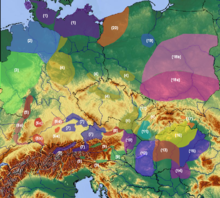Unterwölblinger Group
|
||||||||
| expansion | ||||||||
|---|---|---|---|---|---|---|---|---|
|
||||||||
| Leitforms | ||||||||
|
The Unterwölbling (cultural) group is an early Bronze Age culture , the name of which was coined by Richard Pittioni in 1937 , with regard to the important place where traces of this culture were found in Unterwölbling in Lower Austria . This culture arises from the end-Neolithic bell -beaker culture and is subsequently replaced by the Böheimkirchen group of the Věteřov culture .
Distribution area
The core area of the Unterwölblinger culture extends in north-south direction from the Danube to the Lower Austrian Alpine foothills and in west-east direction from the Enns to the Vienna Woods . In the Upper Austrian foothills of the Alps, elements of the Straubing group and the Unterwölblinger culture mixed together to form the “Linz cultural group”. Preferred settlement areas were the lower reaches of the Danube tributaries Enns , Ybbs , Melk , Fladnitz , Traisen and the Great Tulln .
Craft and cultural technology
While the bearers of the Aunjetitz culture at the same time preferred the bronze casting , which resulted in massive work pieces, the representatives of the Unterwölblinger culture mainly made their metal products from forged sheet metal and decorated them with dots. Among other things, remains of leather caps that were held / decorated by strips of sheet bronze can be found in women's graves as grave goods. Among the pieces of jewelery that can be assigned to this culture were chains with links made of a wide variety of materials (shells, amber, bronze, sheet bronze rolls, bones, etc.), with trapezoidal pendants made of bones and temple jewelry made of wire and worn in pairs. Finds of bronze daggers and ridge hatchets attest to the metallurgical knowledge of this culture. Ornate metal bands were also used to decorate clothing, some of which were made from sheep's wool. A clay spindle whorl , found in Unterhaben , proves that the people who carried the Unterwölblinger culture were already familiar with weaving .
The "Unterwölblinger Cup" as a leading ceramic form is characterized by the threefold structure of the mouth, neck and body, equipped with small ribbon handles, and overall spherical to tubular. Houses were built in post construction, partly as two-aisled long houses (residential buildings) with dimensions of around 20 × 6 meters. The walls were made of wattle and daub . Cattle, sheep, pigs, goats and dogs are to be regarded as pets. Grain meal, wild animals and river mussels completed the food repertoire. Medical acts in the form of skull operations can be proven.
Funeral rites
The bearers of the Unterwölbling culture buried their deceased in a crouched position (with bent extremities) and gender-specific orientation , analogous to the funeral rites of the bell-cup culture . Men were buried with their heads facing north and women with their heads facing south, facing east. Basically, individual burials were common. There were also differences between the sexes when it came to grave goods . Weapons (bronze / stone axes, daggers) can only be found in the graves of men, jewelery predominates in the graves of women, although jewelery (eyelet necklaces, spiral necklaces, bangles, finger rings, jewelery needles, dentures ...) was also worn by men. In the funeral rites there is also a division into at least two social classes. So graves of the upper class were dug much deeper. Various grave finds also show that medical interventions in the head area were already carried out in this culture. From numerous grave finds it can be deduced that the representatives of this cultural group had a low life expectancy for our time and that various deficiency diseases were typical for this culture.
Important sites in Lower Austria
- Unterwölbling
- Franzhausen I
- Commonbars A & F
- Oberndorf
- Ossarn
- Pottenbrunn
- Ragelsdorf ( deposit found )
- Unterradlberg
literature
- Johannes-Wolfgang Neugebauer : Bronze Age in Eastern Austria (= Scientific publication series Lower Austria. 98/101). Verlag Niederösterreichisches Pressehaus, St. Pölten / Vienna 1994, ISBN 3-85326-004-7 .
- Ernst Probst : The Unterwölblinger Group in Austria. A Bronze Age culture from around 2300/2200 to 1800 BC. Chr. GRIN Verlag, Munich 2011, ISBN 978-3-656-03780-4 .
Individual evidence
- ^ Ernst Probst: The Unterwölblinger Group in Austria. 2011, p. 13.
- ^ Parish Nussdorf o. D. Traisen; Primeval Museum.
- ^ Johannes Wolfgang Neugebauer: Bronze Age in Eastern Austria. 1994, p. 69.
- ↑ Ernst Probst: Austria in the Early Bronze Age. GRIN-Verlag, Munich 2011, ISBN 978-3-656-00128-7 , p. 84.
- ↑ Martina Reitberger: The early Bronze Age grave group Rudelsdorf III, KG Hörsching, Upper Austria. In: Yearbook of the Upper Austrian Museum Association. Row 1: Treatises. Volume 148, Linz 2003, ISSN 0376-2556 , pp. 19–45, here p. 32 ( PDF (3.9 MB) on ZOBODAT ).
- ↑ Ernst Probst: Austria in the Early Bronze Age. 2011, p. 84 ff.
- ↑ Ernst Probst: Austria in the Early Bronze Age. 2011, p. 85.
- ↑ Ernst Probst: Austria in the Early Bronze Age. 2011, p. 79.
- ^ Johannes-Wolfgang Neugebauer: Bronze Age in Eastern Austria. 1994, p. 89.
- ^ Johannes-Wolfgang Neugebauer: Bronze Age in Eastern Austria. 1994, p. 79.
- ↑ Ernst Probst: Austria in the Early Bronze Age. 2011, p. 83.
- ↑ Ernst Probst: Austria in the Early Bronze Age. 2011, p. 76 f.
- ^ Johannes-Wolfgang Neugebauer: Bronze Age in Eastern Austria. 1994, p. 83 ff.
- ^ Ernst Probst: The Unterwölblinger Group in Austria. 2011, p. 14.
- ^ Ernst Probst: The Unterwölblinger Group in Austria. 2011, p. 19.
- ↑ Ernst Probst: Austria in the Early Bronze Age. 2011, p. 73 ff.
